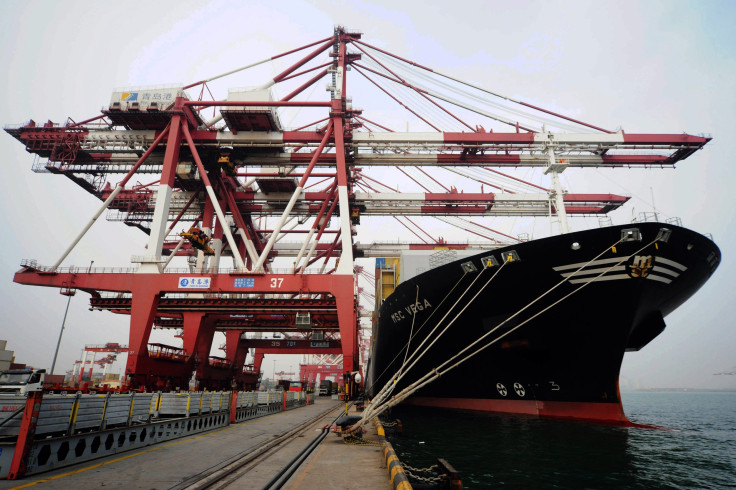China’s Exports Rise In March For First Time Since Last June, Analysts See Signs Of Stabilization

SHANGHAI -- China’s exports rebounded in March, beating market expectations and posting their first rise since June last year. Analysts said seasonal and price factors played a part, but the data could be a sign of stabilization in the world’s second-largest economy, which has seen GDP growth slow sharply over the past year.
China's imports, which have also slumped in recent months, continued their contraction, but the rate of decline – 7.6 percent – was significantly less than February’s 13.8 percent, and better than the 10.1 percent rise predicted by economists polled by Bloomberg.
Chinese stock markets rose on the news, with the main Shanghai Composite Index up more than 2 percent in early afternoon trading.
Exports rose 11.5 percent in dollar terms year-on-year, compared to a dramatic 25.4 percent contraction in February (affected by China's lunar new year holiday), according to figures from China's General Administration of Customs (GAC). A rise had been expected, as exports were unusually low in March 2015, due to the late arrival of Chinese new year. But the figure beat market predictions of a 10 percent rise.
In yuan terms exports rose even faster, by 18.7 percent — due in part to the devaluation of China's yuan by more than 4 percent since last summer — while imports were down just 1.7 percent. Some analysts noted that the cheaper yuan may have boosted exports, but added that, coming soon after better-than-expected factory data for March, the rise could be a sign of a pickup in global demand.
“The export data are solid even after eliminating the base effect,” Raymond Yeung, China economist at ANZ Bank, said in a note sent to International Business Times. He said a “recent pick up of electronic supply chains” in the region may have boosted Chinese exports, particularly of mobile phones — with key producers South Korea and Taiwan also reporting improved shipments of electronics components and semiconductors in March.
HSBC Greater China economist Jing Li said in a note sent to IBT that the slowing contraction of imports may have been affected by a stabilizing of commodity prices, which fell sharply over the past year. However, she added that domestic demand had also been stimulated by an “acceleration in construction activities," boosted by an increase in official fixed asset investment, "thus contributing to the improvement in imports.”
Along with some signs of growing purchasing by Chinese factories last month, this contributed to a 13.4 percent rise in crude oil imports in the first quarter of 2016, compared to a year earlier, and a 30.1 percent rise in imports of copper.
As a result, China posted its smallest trade surplus for a year, $29.9 billion (194.6 billion yuan) in March.
However, HSBC's Li said imports of materials to be processed in China for re-export still contracted 15.3 percent in March “suggesting that the pickup in external demand may only prove to be temporary.” She said the recovery in exports remains “still very fragile.”
And economists noted that in the first quarter as a whole, exports declined 4.2 percent in yuan terms, and 9.6 percent in dollar terms, compared to a year earlier, while imports were down 8.2 percent and 13.5 percent respectively, leaving a total quarterly trade surplus of $125.7 billion. HSBC noted that first-quarter export growth had averaged 6.5 percent over the previous three years.
And while China’s customs agency cited polls that, it said, suggested “exports were likely to start stabilizing in the second quarter of the year,” spokesman Huang Songping accepted that the nation still faces strong downward pressure on its foreign trade:
“The world economy is facing many uncertain factors … Uncertainties of capital flows and resumption of currency wars will exacerbate turbulence in global financial markets,” he said, according to the SCMP.
A spokesman for the Ministry of Commerce last week also acknowledged pressures on China's trade from fluctuations in the value of the yuan – though this has relatively stabilized over the past two months after falling sharply at the beginning of the year – and ongoing “soft” global demand.
The latest trade data showed a differentiation in demand from various parts of the world, with a relatively small — 1.4 percent — fall in exports, in yuan terms, to the European Union in the first quarter, a 3.4 percent fall in those to the U.S., and an 8.5 percent fall in exports to China’s neighbors in the Association for Southeast Asian Nations, the China Daily reported.
China’s Premier Li Keqiang said earlier this week that economic indicators had shown some encouraging signs over the past few months — with a rebound in power consumption, investment and freight figures. And some experts have predicted China will achieve 6.7 percent GDP growth in the first quarter when figures are announced on Friday — above the government's minimum target of 6.5 percent, but below the 6.8 percent for the previous quarter, and 6.9 percent for the whole of last year.
ANZ's Yeung, however, predicted that growth would be just 6.5 percent in the first quarter. And China's Ministry of Commerce said there was still a need for China’s export enterprises to implement structural adjustment and upgrading to remain competitive.
The Chinese government has pledged further reforms this year, aimed at helping the nation move away from low value-added export-oriented manufacturing and state-backed investment to a more supply-side economy, driven increasingly by domestic demand — but some observers have questioned how far the authorities will dare to go in introducing market reforms, which are likely to hit the state-run enterprises that are still major employers in China, particularly hard.
And HSBC's Li predicted further monetary and fiscal easing, saying that the government would need to take "more pro-active policy easing measures ... to support domestic demand and mitigate downside risks brought by persistent deflationary pressures."
© Copyright IBTimes 2024. All rights reserved.





















